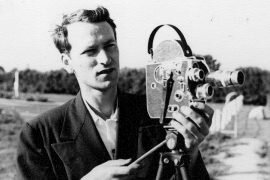Blue Jay (2016), written by Mark Duplass and directed by Alexandre Lehmann, is a sobering wakeup call to confront both past and present emotions before they alter you and your life in unexpected ways. The film’s deceptively mundane plot of two old lovers “catching up” seamlessly conveys the complexities and emotional depth of human beings. It does this through the multifaceted characters of Jim and Amanda (played by Mark Duplass and Sarah Paulson). By deconstructing the characters, the film intricately explores the impacts of past love, loss of identity and the nuances of depression experienced by the middle class.
The juxtaposition of Jim and Amanda is clear from the outset. Jim is desolate and bereft, having lost his job and mother both within a short time. Unexpectedly, he bumps into Amanda, his high school love, at the grocery store. Dejected, he is hesitant and embarrassed to approach her. On the other hand, Amanda is confident, put together and seemingly stable. She lives a polished and balanced life with children and an “incredibly supportive, nurturing, wonderful” husband. As the characters relive their past relationship together, it dawns upon them not only how much of themselves has been lost since deviating from each other, but how little their reality reflects their true identity.
The relationship serves as a time capsule of the levity, passion and authenticity that used to enliven both characters; parts now non-existent in their real lives. From dancing, to playing make-believe, to reminiscing, they are unnerved by the unrecognisable spirits of their younger selves.

A hardened Amanda reveals that although she is running a shelter for dogs, her husband has convinced her not to care for problematic Greyhounds, a passion that Jim reminds her of. She describes how she feels understood by them, a feeling that is noticeably lacking in her marriage: “You can take the oldest, neediness, most anxious, broken-down greyhound and if you take off that dog’s collar, he will just fucking run, like he was still young.” Greyhounds serve as a haunting analogy for the characters. Both of them, battered and trapped by life, are transported back to their youth by releasing each other’s collar. The long-lasting impact of the characters’ choices and disregard of their emotional disturbances have led to not only to a loss of identity but internalised depression.
The significant increase in suicide rates amongst the middle class can be attributed to depression. Indicators include desperation, hopelessness and a loss of purpose and interest in things that one used to care about. The character of Amanda encompasses this: “There is nothing wrong with my life. I should be happy. But there is this sadness and I don’t know where it comes from”. The undercurrent of Jim and Amanda evidently suggest depression. How the characters differ in managing and acknowledging their depression reflects the unique forms it can manifest in.
From the commencement of the film, it is clear that Jim is suffering, although he may be unaware as to the extent that he is. He outright admits to Amanda that he is having a hard time and doesn’t ‘“fucking know what he’s doing”. Whereas, it is only as the film closes does the calm and collected Amanda disclose her despondency, sharing that she is on anti-depressants unbeknownst to her husband.

What is common between the two, however, is their default suppression. It is revealed at the end of the film that what originally broke the characters’ relationship was an abortion. It is apparent that the unresolved feelings of anger, hurt and regret still continues to affect Jim’s emotional stability. Jim, whose sensitivities cause his “face to leak”, uncontrollably cries at any emotional trigger. The result of which led to him to “beating the living shit out” of his uncle. The character recognises that “it was a really scary moment and I had a crack and I feel awful about it”. In comparison, Amanda has not cried in five years. The consequence of her suppression is a stagnant and synthetic life. The film speaks to caution viewers of the harm that will eventuate from repressing hardship, whether it be uncontrollable outbursts or an unrealised life.
Blue Jay is a film that balances the poignant symbolism and mundane plot of the usual independent film with the rhythm and boldness of a large-scale, commercial production. It is a feat that courageously addresses the lifelong, emotional ramifications resulting from neglected pain. It is a masterpiece that perfects human emotion through subtext and subtleties. Lastly, it is an experience that mirrors life, full of heartache and joy.




